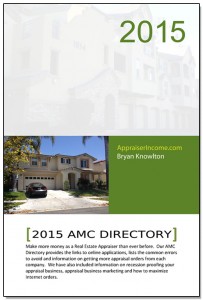Editor’s Note: Discovery in an ongoing appraiser lawsuit against a bank and an AMC uncovers troubling evidence pointing to continued pressure on appraisers to “hit value.” (This story is taken from the new print edition of Working RE – in the mail now! Are you a Working RE Subscriber?)
Blacklisting Lawsuit Continues
by Isaac Peck, Associate Editor
In early 2014, North Carolina appraiser Michael J. McSwain filed a lawsuit against Yadkin Valley Bank and the appraisal management company (AMC) StreetLinks Lender Solutions, alleging that he was retaliated against for failing to reach targeted values. (See Smoking Gun Allows Appraiser to Sue Over Blacklisting)
According to the suit, McSwain performed two appraisals for StreetLinks in late 2012, on behalf of Yadkin Valley Bank, both of which failed to “meet value.” The suit cites explicit emails from the branch manager at Yadkin which state: “StreetLinks has sent out a BUTCHER on two of my last refis [sic] … make sure he is not sent out in our county and make sure he is not on the approval list…I thought I would let him do these two just to see. NOW THE DEALS ARE DEAD.”
Yadkin then demanded that StreetLinks remove McSwain from the bank’s Approved Appraiser List and according to new discovery documents that have been made public, McSwain was placed on Yadkin’s Exclusionary List in early 2013. McSwain then filed a lawsuit in February 2014 alleging that both Yadkin and StreetLinks engaged in unfair and deceptive business practices and were engaged in a civil conspiracy to encourage targeted appraisals.
The lawsuit remains ongoing but many of the facts that have come to light during the discovery process will be of interest to appraisers. More than any recent case, McSwain’s suit raises troubling questions regarding appraiser independence: namely, how much has changed since the Dodd-Frank reforms?
Appraiser Panels
At the heart of the issue is whether AMCs should create and maintain their own independent appraiser panels or allow lenders to handpick the appraisers they want used on their loans. In an interview with Working RE, Chuck Mureddu, managing director of AMC Quality Valuation Services (QVS), said that QVS uses its own panel. “We don’t believe in utilizing a lender’s panel because there’s a risk of diluting the independence part of building a fee panel,” said Mureddu. (See Low Fee Solution: Cost Plus Model)
While independent appraiser panels are not specifically required under Dodd-Frank, many AMCs insist on them in order to safeguard appraiser independence. In fact, StreetLinks’ own Certificate of Compliance, that is issued with every appraisal and is signed by Steve Haslam, StreetLinks’ President and CEO, states that: “Appraiser Selection was performed at the sole discretion of StreetLinks by utilizing a selection methodology designed, maintained, and supervised by licensed real estate appraisers and is based on the criteria of proximity to the Subject Property, availability, and historical quality and performance metrics.”
However, in legal briefs filed as part of the discovery process, StreetLinks states that it “does not decide which appraisers are included on a lender’s exclusionary or preferred list,” writing that such moves are “solely the lender’s internal decision” and that StreetLinks “has no involvement in determining who belongs on the list, or why.”
Loan Production Staff
A central factor in McSwain’s lawsuit is the allegation that both Yadkin and StreetLinks violated appraiser independence by blacklisting McSwain for his failure to “meet value.” So far, Yadkin and StreetLinks deny any wrongdoing, insisting that their actions are completely legal.
The Appraiser Management Services Agreement between StreetLinks and Yadkin states “the lender panel will be delivered by Customer to StreetLinks…and MUST be sent by the Customer’s operations or compliance department directly from the Customer’s corporate office. StreetLinks will not be required to accept Lender Panel information from Customer’s production or sales staff.”
However, the initial suit filed by McSwain cites emails written by Yadkin’s Branch Manager, and a loan officer, which seem to indicate that direct input on the appraiser panel was made by the sales and production staff. The initial email that refers to McSwain as a “BUTCHER” and demands that he be removed from the approved list for “killing deals,” was sent by Yadkin’s Branch Manager, but it was a Mortgage Loan Assistant who ultimately contacted StreetLinks and instructed them to remove McSwain from the approved list. After confirmation that McSwain had been removed, Yadkin’s Branch Manager then forwarded the email chain to several other loan officers with the message: “FYI, I have had two cut deeply by appraiser,” according to the suit.
According to federal regulations, Yadkin is allowed to manage its own appraiser panel, but influence from sales and loan production staff is expressly forbidden. The Interagency Guidelines specifically address this point, stating that the “collateral valuation program is an integral component of the credit underwriting process and, therefore, should be isolated from influence by the institution’s loan production staff” and “the person who selects or oversees the selection of appraisers should be independent from the loan production area.”
Secret Blacklisting
McSwain’s experience is shared by many appraisers across the country who, without warning, suddenly stop receiving work from a client after a “low” appraisal is submitted. The internal emails from Yadkin provide a rare, behind-the-scenes record of what actually happens when a lender is unhappy enough with a missed value to retaliate against the appraiser.
In legal briefs filed as part of discovery, StreetLinks does not address the removal of McSwain from Yadkin’s approved list, but admits that McSwain was placed on Yadkin’s exclusionary list in January 2013 and that StreetLinks did not notify McSwain that he was placed on any exclusionary list. McSwain’s suit alleges that StreetLinks’ failure to notify him of his removal from “its list of qualified appraisers” is against both North Carolina AMC regulations, as well as rules adopted by the North Carolina Appraisal Board, which indicate that AMCs are prohibited from influencing a real estate appraisal by “allowing the removal of a real estate appraiser from a list of qualified appraisers used by any entity without prior written notice to the appraiser” (N.C. Gen. Stat. 93E-2-7 and 21 N.C. Admin Code 57D.0311a). In its discovery answers, StreetLinks expressly denies any obligation to notify appraisers that they are being placed on a lender’s exclusionary list and admits that StreetLinks “has not notified any appraiser that he/she was placed on a lender’s exclusionary list in North Carolina.
It also appears that Yadkin gave StreetLinks instructions to NOT place McSwain on the exclusionary list, but instead to simply remove him from the approved list. However, as part of the discovery process, StreetLinks actually submitted Yadkin’s exclusionary list and it appears that Michael McSwain is on the list.
Regulators Silent
The case remains ongoing in the Gaston County Superior Court and McSwain continues to seek damages from both Yadkin and StreetLinks. It remains to be seen if and when state and federal regulators will become involved in the case. Dodd-Frank defines a violation of appraiser independence as any instance where “A person with an interest in the underlying transaction…attempts to compensate, coerce, extort, collude, instruct, induce, bribe, or intimidate such a person, for the purpose of causing the appraised value assigned, under the appraisal, to the property to be based on any factor other than the independent judgment of the appraiser.”
StreetLinks’ discovery responses seem to provide supporting evidence for McSwain’s contention that he was placed on Yadkin’s Exclusionary List shortly after a Yadkin branch manager referred to him as a BUTCHER and blamed him for two failed deals. According to the suit, Yadkin did not review McSwain’s appraisals for errors or poor judgment and no complaint was ever filed against McSwain for bad appraisal work, nor was McSwain ever notified that he was being removed from an approved list or placed on an exclusionary list. Instead, Yadkin hired other appraisers who submitted appraisals that allowed the two deals to close.
Many appraisers see this case as a clear violation of appraiser independence but so far no state or federal regulators have shown interest in the case. Dodd-Frank mandates a penalty of up to $10,000 per day that the loan exists, so if this case is ever pursued by federal regulators, StreetLinks and Yadkin may each face fines in the millions, since the loans in question were funded in February and March of 2013.
Upcoming Live Webinars:
MAY: Bulletproof Appraising: Fannie Mae, Due Diligence and Your State Board – (Two-Part Webinar)
Presented by Tim Andersen, MAI
Part 1: May 12th, 10 – 11:30 a.m. PST
Part 2: May 19th, 10 – 11:30 a.m. PST
Are you prepared to successfully defend your work against inquiries from Fannie Mae, your state board and your AMC/lender clients? This webinar is designed to share an expert’s knowledge of what it takes to protect yourself. Gained through years of defending appraisers before their state boards, over real-life reporting issues, USPAP expert Tim Andersen, MAI helps you fill in any experience or knowledge gaps in your practice so you can appraise confidently and successfully. Learn More/ Sign Up Now!
JUNE: How to Support and Prove Your Adjustments – A Closer Look
Presented by Richard Hagar, SRA
Part 1: June 4th, 10 – 12:00 p.m. PST
Part 2: June 11th, 10 – 12:00 p.m. PST
“It was a great webinar, now I need to redo all my reports for the last 30 years!” – Sharon
Updated and expanded, Hagar shows you how to properly support your adjustments- the foundation of good appraising! Regulations state that appraisal adjustments cannot be based upon an appraiser’s opinion. Failure to provide proper proof and analysis to support your adjustments means a rough road ahead: state board complaints, panel removal, lawsuits, even license revocation. Fannie Mae cites “the use of adjustments that do not reflect market reaction” as the number one reason an appraiser can be “blacklisted.” This training is critical in helping appraisers avoid catastrophic appraisal failures. Learn More/ Sign Up Now!
 I also updated and added a new chapter on how to use the AMC Directory to sign up only to companies listed in your state. That should save you a bunch of time when applying to the appraisal management companies.
I also updated and added a new chapter on how to use the AMC Directory to sign up only to companies listed in your state. That should save you a bunch of time when applying to the appraisal management companies.











